
- •BlackBox
- •Component Pascal Language Report
- •1. Introduction
- •5. Constant Declarations
- •6.1 Basic Types
- •6.2 Array Types
- •6.3 Record Types
- •6.4 Pointer Types
- •6.5 Procedure Types
- •6.6 String Types
- •7. Variable Declarations
- •8. Expressions
- •8.1 Operands
- •8.2 Operators
- •8.2.1 Logical operators
- •8.2.2 Arithmetic operators
- •8.2.3 Set operators
- •8.2.4 String operators
- •8.2.5 Relations
- •9. Statements
- •9.1 Assignments
- •9.2 Procedure Calls
- •9.3 Statement Sequences
- •9.4 If Statements
- •9.5 Case Statements
- •9.6 While Statements
- •9.7 Repeat Statements
- •9.8 For Statements
- •9.9 Loop Statements
- •9.10 Return and Exit Statements
- •9.11 With Statements
- •10. Procedure Declarations
- •10.2 Methods
- •10.3 Predeclared Procedures
- •Function procedures
- •Proper procedures
- •10.4 Finalization
- •11. Modules
- •Appendix a: Definition of Terms
- •Array compatible
- •Parameter compatible
- •Expression compatible
- •Appendix b: Syntax of Component Pascal
- •Appendix c: Domains of Basic Types
- •Appendix d: Mandatory Requirements for Environment
- •Object Lesson 1 - objects and inheritance
- •Introduction
- •Course Aims - Creating Beautiful Systems
- •Why Design?
- •Design methods
- •Objects
- •How do objects relate to other concepts in design methods?
- •Inheritance
- •The big deal about inheritance
- •Clarity
- •Delegation
- •Relationships
- •One to one relationships
- •One to many relationships
- •Many to many relationships
- •Object Models
- •Exercises
- •Object Lesson 3 Analysis - the rudiments of an approach
- •Removing synonyms and/or generalising
- •Look for attributes
- •Irrelevant objects
- •The process of development
- •Prototyping
- •Evolutionary development
- •Charters
- •Why object modelling lends itself to iterative methods
- •Lesson 4 - Dynamic Modelling - Event traces Dynamic Modelling
- •Event traces - building scenarios
- •Progressing the analysis with event traces
- •What do you do with the event traces?
- •Dynamic modelling - state diagrams
- •An example of an object model for a simple computer
- •An object model for genetic algorithms.
- •Business Activity Modelling - a Starting Point for Software Development Applied to The Functional Specification of a System for Planning Elderly Care in the European Community (planec)
- •Abstract
- •Functional modelling - data flows
- •Use Cases
- •Opening up the use-case requirements model
- •Conclusion
- •Business Process Reengineering
- •Conclusion
Opening up the use-case requirements model
Use-cases allow us to describe at a high level the basic functionality of a system in terms of the various actors who need to interact with the system. We now consider how to flesh out those use-cases, and to link them into the object modelling method we considered earlier.
From the use-cases, which describe broad functionality, we begin to analyse the details of the functionality of the systems we want to construct. Use-cases are broken down into sequences of actions and events. These actions and events are mapped onto objects through object interaction diagrams.
Let us look at the bank example:
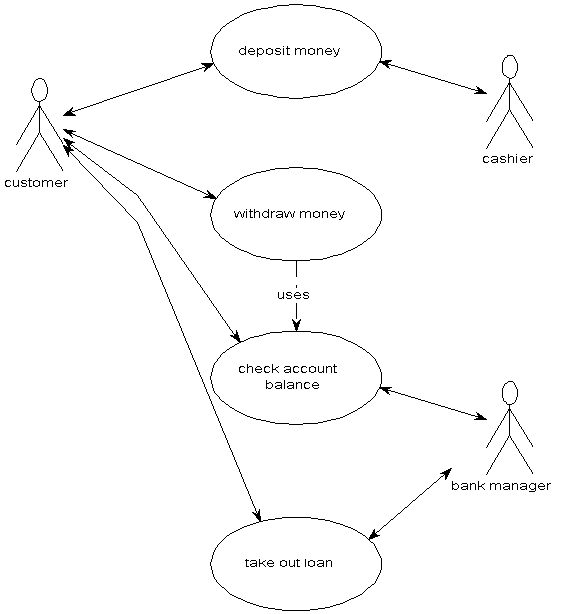
The deposit cash involves the following sequence of actions
Complete pay in slip
Hand cash to cashier
Increase cash balance of account
Increase cashier's balance
Increase bank's balance
Issue receipt to customer
It could be more complicated if we included cheques, but you can do that as an exercise. The link between the requirements model and the object model is built through object interaction diagrams. We can now construct an object interaction diagram something like:
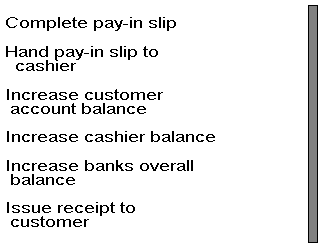
Now we have to consider what objects we might need for interaction. The first debate is whether we want to model the pay-in slip. In the final analysis, the decision to model something as an object depends on how important the behaviour is to the system we are developing. It might be that we only need to record the existence of the pay-in slip, and it can be referenced by an attribute. But to be safe, at first we shall include it as an object.
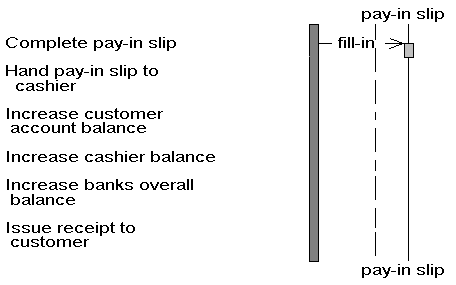
Next we have to decide if we wish to model the cashier. Again, at first it is better to model something as an object and reduce its status to an attribute (say) or remove it from the system at a later stage. So we include a second object.

Now we have to worry about the customer and his/her account(s). Now a customer may have more than one account, normally. So it seems sensible to model both. Here, however, we merely need to know about the account. In fact the person depositing money may not be the owner of the account.
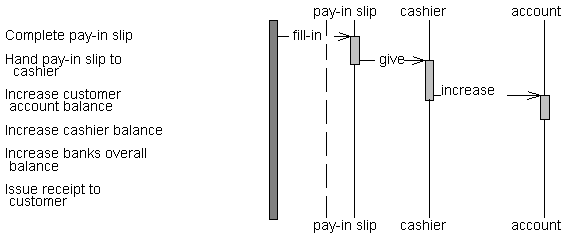 Now
we are left with trying to understand where the cashier balance might
be stored. We might want to create an object for this, or store this
as an attribute of the cashier object. There seems no need to keep a
cashier balance separate, so we shall record the cashier balance in
the cashier object.
Now
we are left with trying to understand where the cashier balance might
be stored. We might want to create an object for this, or store this
as an attribute of the cashier object. There seems no need to keep a
cashier balance separate, so we shall record the cashier balance in
the cashier object.
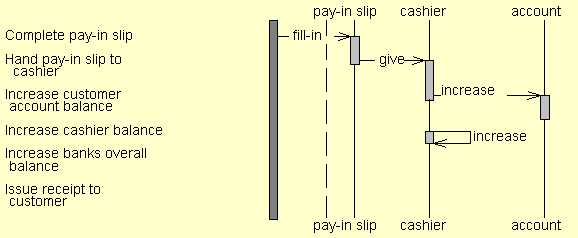
Now we are left with a decision about whether to keep a bank object. It seems reasonable, even though there may only be one. (Alternatively, we might think of the bank having many branches, and have to increment the branch balance. Let's keep it simple though.)
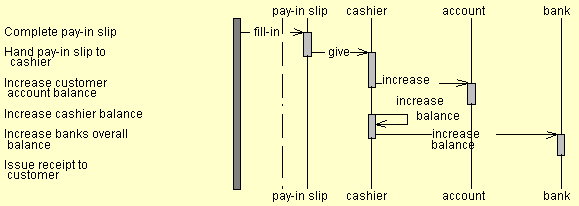
Now we have to decide whether to include the customer object. At this stage, the thing we are talking about is a real, physical customer. Hence we might leave a customer object out of the interaction diagram.
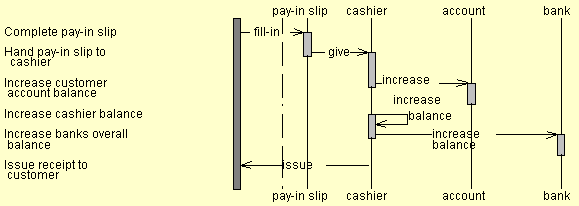
And so we progress. Now it is almost certain that two analysts working on the system would come up with different decisions at each stage. There is no single, definitive answer. Hopefully the set of objects derived by independent analysts would be similar, but any expectation that analysis is a deterministic activity with right or wrong answers is bound to be frustrated. Of course, there are good and bad analyses and designs. A large part of what makes for good design comes from experience.
In a nutshell, the first step from requirements analysis to detailed analysis is through the use of object-interaction diagrams to define objects, their behaviour and their attributes. These objects will be found in many interaction diagrams, and their overall behaviour is a composite of the behaviours from the individual interaction diagrams.
Having found some of the behaviours of objects in this way, we can then produce state-transition diagrams for the objects to more tightly define their behaviour. Our initial analysis can progress beyond functionality towards some architecture to support that functionality.
There are many techniques for driving the analysis. An analysis should involve the appropriate parties in the development of the system. There is not enough scope in this course to discuss methods of interviewing. One useful technique, however is to provide some discussion around the interface of the use-cases with the actors. This has the advantage that it begins to open up the way the system may be used, and it defines both attributes and operations the use-case needs to take into consideration.
For example, suppose we wished to discuss with a bank manager what happened when he/she checked an account balance. We might draw up a possible screen and describe it to the bank manager, asking for feedback on the suitability of the screen, its contents, and what the bank manager would expect to be able to do through the screen. It can be related to the use case diagram as below.
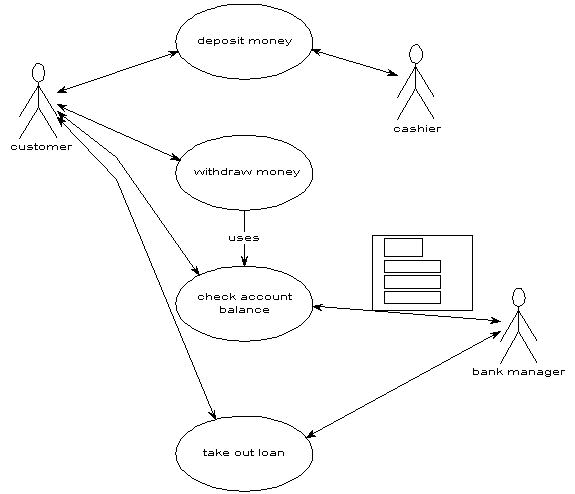
As the analysis progresses through to design, interface objects will have to be designed to drive the interfaces with the various actors, and effectively implement the use-cases as objects in their own rights. Use-cases can be thought of as objects whose behaviour is defined in terms of other objects in the system.
Abstract analysis and design can progress a long way before taking into consideration the hardware and software requirements for implementation. Arguably it is better to defer the decisions about implementation as far down the line as possible, though in practice it is often important to have some idea of the basic hardware and software configurations which will be available; in many practical projects these will be given as part of the existing infrastructure or policy of the client.
